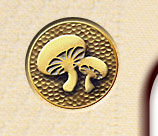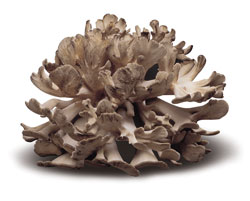


Grifola frondosa
Preparation and Serving Suggestions:
Do not wash this mushroom. Just slice and sauté in butter or oil. Maitake is wonderful in egg dishes, tempura, pasta sauces, soups, stews, and any other recipe calling for mushrooms. It adds a rich flavor to any dish.

Maitake means 'dancing mushroom' in Japanese; a name for which at least two explanations have been offered. One is that the overlapping leaflets of the mushroom resemble butterflies in a wild dance. Another is that ancient Japanese fortunate enough to find Maitake growing wild would dance with joy because it could be traded for its weight in silver. Another common name for Maitake is Hen-of-the-Woods. Maitake mushrooms form a brown to gray cluster of petals or fronds on a fused, central stalk. Medicinally, maitake is best known for its immune-enhancing properties. It has been recognized to be helpful in the treatment and prevention of certain kinds of cancers, high blood pressure, diabetes and high cholesterol.
Reported Health Benefits:
For thousands of years Maitake mushrooms have been revered in China and Japan as a food to maintain health, preserve youth, and increase longevity. Within the last 20 years there has been an increased scientific interest in the study of Maitake and its healing properties. Maitake has been recognized to be helpful in treatment and/or prevention of the following:
* Cancer
* HIV/AIDS
* High Blood Pressure
* Diabetes
* Obesity
* High Cholesterol
Selected References:
Adachi, K., et al. 1988. Blood pressure-lowering activity present in the fruit body of Grifola frondosa (maitake). Chem Pharm Bull. 36(3): 1000-1006
Borchers, A.T., et al. 1999. Mushrooms, tumors, and immunity. Proceedings of the Society of Exp Biol Med, 221(4): 281-93
Hobbs, Christopher, L. Ac. 1995; Medicinal Mushrooms, an Exploration of Tradition, Healing, and Culture; Botanica Press, Santa Cruz, CA pg. 194
Jong, S. C., et al. 1990. The medicinal value of the mushroom Grifola. World J of Micro and Biotech. 6:227-235
Kubo, K., et al. 1994. Anti-diabetic activity present in the fruit body of Grifola frondosa (Maitake). I. Biol Pharm Bull 17(8):1106-1110
Mizuno, Takashi and Cun Zhuang. 1995. Maitake, Grifola frondosa: Pharmacological Effects. Food Rev Int, 11(1): 135-149
Ohtsuru, M. 1992. Anti-obesity activity exhibited by orally administered powder of maitake mushroom (Grifola frondosa). Anshin. July: 198-200
Wasser, S.P. and A.L. Weis. 1999. Medicinal Properties of Substances Occurring in higher basidiomycetes Mushrooms: Current Perspectives (Review). Int J of Med Mushrooms. Vol. 1(1) :31-62
Yamada, Y., et al. 1990. Antitumor effect of orally administered extracts from fruitbody of Grifola frondosa (Maitake). Chemotherapy. 38: 790-796
Zhuang, C. and T. Mizuno. 1999. Biological Responses from Grifola frondosa (Dick.:Fr.)S.F.Gray. Int J of Med Mushrooms. Vol. 1(4):317-324
© Copyright 2005 Phillips Mushroom Farms, Inc.